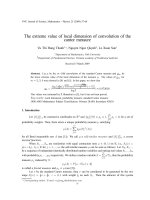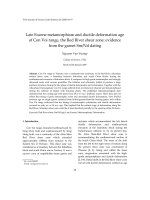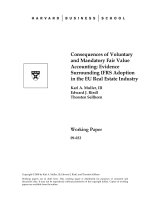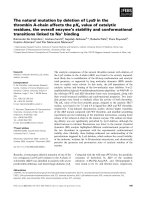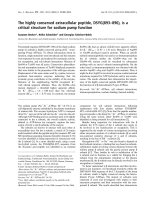Preserve and promote the value of the Xoe Thai heritage in the context of cultural integration
Bạn đang xem bản rút gọn của tài liệu. Xem và tải ngay bản đầy đủ của tài liệu tại đây (1.04 MB, 7 trang )
VĂN HÓA TRUYỀN THỐNG VÀ PHÁT TRIỂN
PRESERVE AND PROMOTE THE VALUE OF THE XOE THAI
HERITAGE IN THE CONTEXT OF CULTURAL INTEGRATION
Nguyen Nguyet Thu
Vietnam Academy for Ethnic Minorities
Email:
Received: 25/9/2019
Reviewed: 10/10/2019
Revised: 20/10/2019
Accepted: 9/11/2019
Released: 20/11/2019
DOI:
X
oe Thai art is a unique traditional dance form associated
with the life of Thai people in Northwestern Vietnam
in community festivals, funerals, art festivals, making friends,
exchanges... This art transmitted and preserved quite intact
over hundreds of years with many different forms. In 2013, this
art form was recognized by the Ministry of Culture, Sports and
Tourism as a National Intangible Cultural Heritage. In 2018,
the Prime Minister agreed to build a profile of Xoe Thai Art to
submit to UNESCO for consideration and inclusion in the list of
Representative Intangible Cultural Heritage of Humanity. The
heritage profile is expected to be completed in December 2019.
Thus, the vision for this art form will be raised to an international
level; Thereby, the awareness of the local community in continuing
to preserve and promote unique values in the traditional cultural
capital of the Thai people in particular, the diversity and richness
of the cultural identity Vietnam in general is also more profound.
Từ khóa: Xoe Thai art; Thai people; Northwest; Preserve and
promote; Intangible cultural heritage.
1. Introduction
Xoe Thai is a unique traditional dance,
occupying an important position in the life of the
Thai community in the Northwest of our country,
typically in Phong Tho district (Lai Chau) and
Muong Lay town (Dien Bien), Quynh Nhai district
(Son La), Nghia Lo district (Yen Bai). Xoe Thai
has been transmitted and preserved quite intact
over hundreds of years with many different forms:
Using in community activities to express and make
friends; Expressing ideas about spiritual roots...
Xoe Thai are popularly performed in community
festivals such as Kin Pang Then, Xen Tra, Xen
Lau No, Het Cha, funerals of Thai people, and also
performed in fun events, music festivals. Xoe Thai
art is ethnic, community-oriented, showing the
identity of the Thai people. In addition to the dances
with fan, scarf, hat, music, Thai people also have a
lot of dances named events, content, props such as:
Chan Khon, Kep phac, Kep Bok...
Xoe Thai art is a property, a bond to connect the
community, the core of national identity and the basis
for creating new cultural values in contemporary
life. Therefore, this art form has been recognized
by the Ministry of Culture, Sports and Tourism in
the National Intangible Cultural Heritage list since
2013 and has been approved by the Government to
Volume 8, Issue 4
build a national profile for submission UNESCO
for approval of the list of Representative Intangible
Cultural Heritage of Humanity in 2018. The Ministry
of Culture, Sports and Tourism has assigned the
National Institute of Culture and Arts to preside and
coordinate with the Department of Culture, Sports
and Tourism in the provinces of Dien Bien, Lai
Chau, Yen Bai, Son La and related agencies to build
heritage profile “ Xoe Thai Art”. Thus, the vision
for this art form has been raised at the national and
international level; Thereby, the awareness of the
local community in preserving and promoting the
values of Xoe Thai also deepened. This is also an
opportunity to promote the development of this
art form, to Xoe Thai into a unique tourist product
of the Northwest cultural region. However, the
preservation and promotion of heritage values to
deserve the title is also a big problem posed in the
context of increasingly intensive and widespread
cultural integration today.
2. Research overview
Xoe Thai Art is the result of artistic creation
stemming from the labor of the Thai community in
order to meet their first cultural enjoyment needs.
This art form becomes a means of communication,
community connection, symbolizing solidarity,
crystallization of life experiences and creative
115
VĂN HÓA TRUYỀN THỐNG VÀ PHÁT TRIỂN
thinking in daily life of Thai people; it’s conection
to help the community more understand about the
Northwest people’s life and contribute to the beauty
of Vietnamese folk dance... This is a big area of
research by many scholars on art and cultural interest.
There have been quite a lot of books and
researches that take Xoe Thai as a research subject.
For example, the book “Vietnamese Ethnic Dance
Art” (1979) by author Lam To Loc, “Vietnamese
Folk Dance” by Le Ngoc Canh, “The Folk Dance
Heritage of the Northwest Region” (1998) by
author Chi Thanh... refers to the typical Xoe dance
of the Thai ethnic group, showing its speciality,
distinctive, generalized characteristics, representing
the region in the system of Vietnamese folk dance
cultural values. Particularly the Xoe Thai Art, there
are many in-depth studies. Typically, “Xoe Thai
a unique stage of development” (2007) by Bui
Chi Thanh includes the contents: Thai people in
Vietnam, Xoe teams, some Xoe Thai folk dances in
Northwest. The book presents quite a full range of
developments from folk dance to dance performed
on stage and steps to improve Xoe Thai, thereby
referring to the changes of Xoe Thai period.
Researchers Dang Nghiem Van, La Van Lo, Cam
Trong, To Ngoc Thanh, Do Thi Tac... also have
many contributions in researching and collecting to
preserve and promote this type of art. Besides, there
are also many doctoral and master theses who choose
Xoe Thai as the subject of research, specifically:
Thesis “The role of Thai folk dance in the dance
training system in Vietnam” (2005) by Nguyen
Thuy Nga; The thesis “Preserving and developing
Xoe Thai in Northwest” (2010) by Le Minh Thu ...
However, the latest and most comprehensive work
on the Xoe Thai Art is “The Inventory Report of
Xoe Thai Art Heritage” (2019) for the purpose of
document preparation, submitting to UNESCO for
recognition The Xoe Thai Art as a Representative
Intangible Cultural Heritage of Humanity.
Accordingly, the researchers pointed out, before
the August Revolution (1945), when Lai Chau
province (old) in particular and the Northwest
region in general was still cloudy with the shortage
and backwardness, the region Muong So of Phong
Tho and Muong Lay districts (Muong Lay town,
Dien Bien province today) has been famous as the
land of fascinate enchanting Xoe dances.
According to experts, Xoe has many types.
Probably the earliest is Xoe Vong dance. This dance
is collective, has high community interaction, so the
number of participants is not limited. Initially, the
circle may be only 5-6 people, then add gradually,
regardless of old or young, girl or boy, village
people or other villagers, even visitors can attend
116
the round. Up to now, the biggest circle known by
many people and recorded a record is the Big Show
performance to celebrate the Certificate of National
Intangible Cultural Heritage “Xoe Thai - Muong
Lo, Nghia Lo” in 2013 with the participation of
2033 people, including 2013 people practiced 6
ancient melody dances and 20 people participated
in traditional orchestra. Currently, in Cang Na
village, Trung Tam ward (Nghia Lo town, Yen Bai
province), folk artisan Lo Van Bien is a person who
spends a lot of time researching and transmitting
unique ancient melodies of Thai people in Muong
Lo for compatriots in around the region. He is the
one who has restored the 6 ancient melodies with
souls of Muong Lo land, including: Khắm khen
(ie Holding hands together), Ðổn hôn (ie Step
backward), Phá xí (ie news Dad), Nhôm khăn (ie
Spread the scarf), Khắm khăn mơi lảu (ie Raising
scraft inviting wine); Ỏm lọm tốp mư (ie Clapping
your hands in a circle).
With the special, flexible and lively of Xoe Thai
Art, the professional choreographers and musicians
have taken Xoe Thai on many stage performances.
The study also noted: After the victory of Dien Bien
Phu in 1954, at the hands of the choreographers,
Xoe was adjusted and gradually improved,
upgraded to performing arts. Besides, the musicians
also quickly joined in, contributing to bringing the
circle beyond the village playground to come to
many modern stages. In 1952, during the program
of World Youth Festival held in Berlin (Democratic
Republic of Germany), dance artist Phuong Thao of
the General Department of Political Dance of the
Vietnam People’s Army was the first to introduce
the Xoe Non Muong Lay (dance with hats) with
international friends. One of the people who helped
to change this dance was People’s Artist, Colonel
Do Minh Tien - a military musician with a lot of
enthusiasm for folk dance art in the Northwest...
(Viet, 2016, pp.1-2)
Xoe Thai has been transmitted and preserved
quite intact over hundreds of years. That is the basis
for creating new cultural values in contemporary
life, is the basis for preserving and promoting the
value of the heritage in the culture exchange and
integration takes place more deeply and more
widely today. This is the problem that needs to be
further studied, in order to find a way for the Xoe
Thai Art to deserve the title of heritage.
3. Research method
The paper uses three basic research methods:
Method of document analysis, synthesis method
and descriptive method.
Accordingly, based on the references, existing
studies, articles analyzing the characteristics and
JOURNAL OF ETHNIC MINORITIES RESEARCH
VĂN HÓA TRUYỀN THỐNG VÀ PHÁT TRIỂN
advantages of Xoe Thai art, thereby pointing out the
necessity and urgency of preserving and promoting
the value of the heritage when it is recognized by
UNESCO as a Representative Intangible Heritage
of Humanity, especially in the context of cultural
integration takes place more deeply and widely on
a global scale.
In addition, the article also describes the situation
and achievements of preserving and promoting
the value of Xoe Thai National Heritage through
surveys, information gathering and interviews
with cultural managers, people directly involved
in heritage conservation, and scholars specializing
in cultural conservation. From there, propose some
solutions to promote the Xoe Thai heritage in the
context of cultural integration.
4. Research results
4.1. Achievements in preserving and promoting
the value of Xoe Thai National Heritage
4.1.1. Restore and stylized Xoe
Depending on the calling of the community of
villages/ hamlets/ neighborhoods and clubs, Xoe
Thai has many names: Xoe dance, Xoe Thai, Xe,
Then dance, Then sing, Mo, Xoe Dance Art, Xoe.
However, among those names, there are 3 most
popular names are Xoe Thai, Xoe and Xe.
Folk culture researcher Do Thi Tac said that,
in terms of origin, Xoe first originates and is
associated with religious activities. The Xoe
contributes to show the Thai people’s view of the
universe and human life through ritual activities
of shamans and practitioners who are sick or who
believe in spirits. The dances of Then worshiping
are the most concentrated expression of the dance
forms (Kin Pang Then Festival), with various
forms of dance/Xoe offering ceremony, praying for
prayers, dancing for welcoming souls, and offering
ceremony thank the heavenly soldiers for saving the
sick. Accompanied by the Xoe dances, the lyrics
contain many philosophies of human life and hide
the human conception of the universe and people
(Thanh et al., 2019, p.16)
The folk artisan Lo Van Bien (Nghia Lo, Yen
Bai) said: “Xoe attracts people from all walks of life,
regardless of age, old and young, men and women,
rich and poor and social groups. Xoe has stimulated
production labor, after hard working hours, people
are merged with the joyful atmosphere, integrate
with nature, hold hands to dancing to forget all
worries and tiredness, balancing the physiological
psychology, creating a sense of excitement between
people who love each other more, love life more,
more enthusiastic production workers (Thanh et al.,
2019, p.17)
Volume 8, Issue 4
Over the last decade, Thai people in almost
every village have gradually restored the traditional
Xoe dances in the past, becoming a form of folk
dance with an artfully complete way of a Xoe - a
typical collective dance in the traditional way. From
belief dance in rituals, Xoe had been stylized the
movements in daily life, labor, production... to form
three main categories: Religion, entertainment and
performance. To meet the operational needs of the
community life, the intellectuals of the Muong have
created more Xoe dances to express the rich inner
character of the people, some of them spread with
the props and named as props, such us: Xoe Khan
(Craft), Xoe Non (Hat), Xoe Nhac (music), Xoe
Gay (stick), Xoe Chai (bottle)... Xoe Vong (Circle
Xoe) is common in important cultural events in
the community and family with the participation of
many people. There are basic movements that are:
Swinging hands, opening hands, holding hands,
footsteps, lifting feet, shrugging, right tilting, left
leaning. Accompaniment instruments for Xoe
include large drums, small drums, Cong, Chieng,
pipe-taps, music, horns and cymbals. The rhythm of
the melody varies in the quick and slow movement of
the dance, in the process of simulating the Then to the
sky journey, finding the soul to enter the body... The
gentle, soft and flexible dance movements combine
smoothly to music, traditional costumes make Xoe a
form of folk art imbued with the cultural identity of
the Thai people in the Northwest.
In recent years, the young generation has
brought to Xoe new shades in many forms and
gestures. The rhythm of the song also reflects
the new emotional rhythm of contemporary Thai
people. From the baby dancing to the elderly, the
girls and boys exchange their feelings not with
words but with the eyes of smiles, clenched fists,
leaving warmth of hand in the visitors’s emotion so
passionate and unforgettable. The Xoe movements
and the current dances have new lines due to the
changes of the main movements inherent in the
traditional Xoe. Some of the movements were
modified, props used in addition to towels also have
fans in the Fan dance, the hat in the Hat dance, the
flower in the Flower dance. Each village formed a
team of Xoe performers, trained by artisans in the
village, to train to perform exchanges with other
localities. Especially in Nghia Lo town, since
2017, the Xoe team has been established with up
to 1,500 people, gathered from the Xoe team in the
villages with the main purpose to go to perform to
serve Tet holidays and large cultural festivals was
organized in Yen Bai province, or participated in
the Northwest Cultural Ethnic Festival, Back to the
Source Tourism Festival (combining 3 provinces of
Lao Cai - Yen Bai - Phu Tho).
117
VĂN HÓA TRUYỀN THỐNG VÀ PHÁT TRIỂN
4.1.2. Expand the space of practicing Xoe heritage
Xoe are held in Thai people’s villages in four
Northwestern provinces, including the districts of
Van Chan, Mu Cang Chai, Tram Tau and Nghia Lo
towns (Yen Bai province); the districts of Phong
Tho, Sin Ho, Nam Nhun, Tan Uyen, Than Uyen,
Muong Te, Tam Duong and Lai Chau cities (Lai
Chau province); the districts of Muong La, Thuan
Chau, Mai Son, Song Ma, Yen Chau, Sop Cop, Bac
Yen, Van Ho, Phu Yen, Quynh Nhai, Moc Chau and
Son La cities (Son La province); the districts of Dien
Bien, Muong Cha, Dien Bien Dong, Tuan Giao,
Muong Ang, Tua Chua, Muong Nhe and Nam Po,
Muong Lay town, Dien Bien Phu city (Dien Bien
province). The areas considered to be the center of
Xoe are Muong Lo (Yen Bai), Muong So (Lai Chau),
Muong Lay and Muong Thanh (Dien Bien).
In Yen Bai province, Xoe had practiced in
4 districts/towns with 15 communes/wards and
102 villages/hamlets of Thai people. A total of
1,200 people of all ages practicing Xoe in 180
performance teams. In 2015, there were 2 artists
who were awarded the title of Excellent Artist (Lo
Van Bien and Dieu Thi Xieng).
In Son La province, there are 1,471 people
practicing Xoe Thai in 119 villages in 6 districts and
towns, including many ages with different roles such
as Xoe artists (who has many experience years of Xoe
dance), instrument players, practitioners and young
people are practicing. Basically, this force is currently
operating regularly in the form of Xoe teams in
villages, 6 districts and towns with 6 artists who were
awarded the title of Xoe Thai Artists in 2015.
In Lai Chau province, the Thai community
living in the districts of Phong Tho, Sin Ho, Nam
Nhun, Tan Uyen, Than Uyen, Muong Te, Tam
Duong and Lai Chau city organize activities of Xoe
at 100 village performance teams with more than
1,200 participants. In 2015, 4 people were awarded
the title of Excellent Artist by the State.
In Dien Bien province, Xoe Thai is practiced
in 10 districts/towns with 150 villages and 1,273
performance teams. Surveying the number of Xoe
Thai artists who have been awarded by the State,
until August 2018, Dien Bien had 03 Xoe Thai
artists who were awarded the title of Excellent
Artist by the State (Mao Van Ot, Luong Thi Dai and
artist Hoang Thim - lost).
For Thai people, a Xoe dance event usually takes
place in a flexible, not fixed space. Previously, the
space for dancing activities could be in a family with
large stilted houses, or a family having fun event
(weddings, housewives…), who want to invite
villagers to share the joy. That space can be next to
the field or on the banks of the stream, dancing Xoe
118
out between the hard labor sessions. But the most
common space is the large vacant yard between
the residential area of the villagers. Later, due to
the development conditions of society in general
and villages in particular, most of the villages had
village cultural houses, used for meetings and
organizations for various forms of community
life activities, in which activities of performance
teams of Xoe dance takes place here. In addition,
depending on the purpose of the organization, the
Xoe activities may take place in different wide/
narrow spaces (celebrations, big ceremonies held in
squares, stadiums of communes/wards).
94.9% of the community said that they
regularly Xoe dance in the weddings and the new
house celebrations; 86.2% regularly Xoe danced
in the holidays organized by the authorities; 70.4%
frequented the Xoe dance in traditional festivals;
Other festivals also often have Xoe dance as union
activities (63.6%); according to the schedule of
clubs and performance teams (60.2%); holidays
(54.1%). A smaller percentage in traditional
offerings is only 12.4%; 8.4% have Xoe in life cycle
rituals. Particularly, the practicing Xoe dance in
the funeral currently only has 3 villages in Van Ho
district (Son La) and 2 villages in Nghia Lo town
(Yen Bai) (Thanh et al., 2019, pp. 25-26)
According to the data published in “The Inventory
Report of Xoe Thai Art Heritage”, 100% of the
surveyed people believe that the activities of Xoe in
general and the practice of traditional Xoe in particular
of Thai people up to now is still the main cultural
activity of Thai villages/hamlets, meeting the needs
of exchanges and entertainment for all generations,
adding the funny to the daily life of the hamlets and
villages, especially at the beginning of the new year
and free time after the seasons. The actual survey
results show quite clearly the diversity in the cultural
life of the community, in which, Xoe dance plays the
leading role, an indispensable spiritual product in the
life of the Thai ethnicity community.
4.2. Issues raised in the process of preserving
and exploiting Xoe Thai heritage values
In fact, the majority of localities are limited in the
collection and recording of historical and cultural
relics as well as the process of local traditional
cultural heritage. The main reason for this situation
is that the current number of people know Thai
writting is still very small, even some localities have
no one. A part of the youth from primary to high
school is at risk of not reading and speaking their
native language. The performance environment of
Xoe Thai art has been affected quite extensively of
space, living time and identity of props, costumes,
musical instruments for cultural activities in general
JOURNAL OF ETHNIC MINORITIES RESEARCH
VĂN HÓA TRUYỀN THỐNG VÀ PHÁT TRIỂN
and Xoe art in particular. Fewer and fewer people
make their own costumes, jewelry... by traditional
crafts. This will be one of the predictive causes
limiting the process of preserving and transmitting
ethnic cultural heritages.
Along with that, most of the villages that are
maintaining traditional cultural activities have
a tight economic situation, do not have enough
material capacity to build a folk song learning
movement, organize various forms of extensive
dance as before. Performance teams, who are
directly teached Xoe Thai art, especially artisans,
receive little attention both mentally and materially.
Many elderly artisans with a long reputation are
not entitled to subsidies, honor and exploit the
inheritance they hold in time. Therefore, a part
of the heritage and knowledge of ethnic cultural
heritages has disappeared, causing disadvantages
to Thai ethnic community culture in particular and
the national culture in general. Without additional
funding for teaching and restoring traditional
cultural life in the villages, this is also a barrier for
the preservation and promotion of heritage values.
In addition, some local governments still lack
dynamism and creativity in expanding relationships,
mobilizing organizations and social sectors to
participate in preserving, exploiting and promoting
the heritage values in the locality. Due to the limited
socialization of heritage conservation, there is not
enough force to create the attraction of the heritage
and the heritage transfer process between generations,
as well as develop community tourism. Even the
link between local schools and the protection and
promotion of the heritage values of villages/hamlets
is not strong. Propaganda and education do not form
a sweeping movement in the community; In some
localities, the dance teaching still largely depended
on the awareness and subjective awareness of music
teachers and class teachers.
Another important issue also posed by many
researchers when it comes to preserving and
promoting the Xoe Thai heritage: Should Xoe Thai
remain original or let it change with today’s life?
Because the Xoe Thai artisan Lo Van Ben (Yen Bai)
expressed his view not to support the “overshoot”
modifications, to “lose all the ancients”, the heritage
must be preserved in its original state. Or Prof. Dr.
Truong Quoc Binh (National Cultural Heritage
Council) shares, reconsidered modification will
hurt the integrity of the heritage. (Opinions at the
International Scientific Conference “Protecting
and promoting the value of Xoe Thai Art in
contemporary society” took place on October 4,
2019 at the Vietnam National Village for Ethnic
Culture and Tourism). This is also an aspect that
Volume 8, Issue 4
needs to be researched when preserving and
promoting the value of Xoai Thai heritage.
5. Proposal for the preservation and
promotion of the value of the Xoe Thai
Having a great significance in the spiritual life of
the Thai people in particular and ethnic minorities in
general, the Xoe Thai art has been concerned by all
levels and branches of Yen Bai, Lai Chau, Son La
and Dien Bien provinces preserves and continues to
maintain. The survey of the team implementing “The
Inventory Report of Xoe Thai Art Heritage” shows
that 100% of Thai people and local authorities are
enthusiastic and excited about building a Heritage
Profile submitted to UNESCO for consideration of
Xoe Thai as The Representative Intangible Cultural
Heritage of Humanity. Xoe Thai is recognized as a
world heritage, it means that the preservation and
promotion of the heritage value will be more urgent
and methodical. Preserving and promoting the
value first of all is to Xoe Thai with the title of the
Representative Intangible Heritage of Humanity, and
to uphold the title awarded by UNESCO.
As well as 11 intangible heritage sites of Vietnam
have been honored by UNESCO (including 9
Representative Intangible Heritage of Humanity
and 2 Urgent Protective Intangible Heritages),
conservation and promotion of heritage mainly to
the community, especially the localities where it is
held. Hue Royal Court Music, Tay Nguyen Cong –
Chieng Cultural Space, Bac Ninh Folk Songs, Ca
Tru, Xoan Singing, Southern Folk Music Genres
... are like that, born in the community and well
maintained, “grow up” in the community. After
being honored as the Representative Intangible
Heritage of Humanity, the preservation and
promotion of that heritage is also mainly in the
hands of the local people where it is located. Of
course, it is indispensable to support both in terms
of policies, material and spiritual of the State and
local authorities.
Xoe Thai has been maintained and developed
as such over the centuries, mainly thanks to the
ethnic minority community holding the heritage
with the support of local authorities. A typical
example is in Yen Bai province, before 2005,
when the locality had not organized Back to the
Source Tourism programs, the Xoe dances were
still maintained regularly by the community during
the village festivals but only are the freestyle Xoe
dances with stylized, variations such as Xoe Vong
(Circle), Xoe Khan (Craft), Xoe Non (Hat), Xoe
Chai (bottle), Xoe Hoa (flower), Xoe Nam Tay
(holding)... Since 2005, tourism programs and
cultural weeks have been organized more and more
often, the Xoe dances have been expanded in scale,
119
VĂN HÓA TRUYỀN THỐNG VÀ PHÁT TRIỂN
paying more attention to the form and content of
expression. In addition, the artisans have translated
and disseminated the 6 ancient Xoe dances to the
community, so the ancient Xoe art has initially been
restored and gradually developed. In recent years,
aware of value of ancient Xoe heritage, localites
have organized many activities to popularize this
heritage practice process such as organizing the
teaching of 6 ancient Xoe dances for the villages;
invite artisans and a number of individuals to restore
the ancient Xoe Thai dances, open the class of
pipe-making and alpine music; teach to the staff of
Nghia Lo town, then the staff will go directly to the
communes, wards, villages and hamlet to teaching.
Each village has at least one ancient Xoe team, the
number of people participating in the ancient team
is increasing. Xoe is defined as a key in cultural and
artistic activities of the region...
Or in Dien Bien province, the Department of
Culture, Sports and Tourism of the province has
advised to develop the program to celebrate The
Historic Victory of Dien Bien Phu in even years,
Ethnic Cultural Festival, Hoang Cong Chat Festival
at Ban Phu temple, carrying out the preservation
of traditional festivals such as Kin Pang Then,
or activities in cultural villages associated with
tourism development... Xoe Thai is put into
practice in social - cultural events of local attract
a large number of officials, people and tourists. In
the past years, with the investment program from
Governmental and non-governmental organizations
(donated by The National Target Program and The
Danish Fund), there have been many projects on
folk songs conservation, folk dance and teaching
traditional instruments. This is considered to be
one of the important motivations contributing to
the conservation of folk dance art as well as the
instruments used to express the beauty of folk dance
in general and Thai Xoe Art in particular. In recent
years, the program of cooperation among branches
to implement the emulation movement “Building
Friendly School - Active Students” has integrated
the folk performing arts program, including the
120
Xoe art on extracurricular programs. This is very
valuable in preserving the Xoe Thai art. Dien Bien
province is also borders to China and Laos, so
there are frequent occasions of art performances,
cultural exchanges with the their team, so Xoe Thai
art has more opportunities to introduce. Especially,
the Executive Committee of Dien Bien Provincial
Party Committee also issued Resolution No. 09/
NQ/TU of December 20, 2012 on the program of
preserving and developing ethnic groups in Dien
Bien province in association with economic society development to 2015, orientation to 2020
with the main task of preserving ethnic cultures;
invest in developing, raising the value of ethnic
cultural identities, promoting the role of social
factors participating in preserving and developing
ethnic cultures. The People’s Committee of Dien
Bien Province issued Decision No. 401/QDUBND on June 12, 2013 approving the Project on
Preservation and Development of Ethnic Minority
Culture in Dien Bien Province in association
with economic - society development to 2015,
orientation to 2020. That is the reliable fulcrum for
Xoe Thai development and sublimation in ethnic
communities.
6. Conclusion
The value and vitality of Xoe Thai art has been
affirmed and transmitted for hundreds of years
throughout Northwestern Vietnam, especially in
the Thai ethnic community in 4 provinces of Dien
Bien, Lai Chau, Yen Bai and Son La. Xoe Thai art is
really a property, a bond to connect the community,
the core of national identity and the basis for
creating new cultural values in contemporary
life. This type of art deserves to be in the list of
The Representative Intangible Cultural Heritage
of Humanity voted by UNESCO. Therefore, the
preservation and promotion of heritage values in the
context of cultural integration takes place more and
more widely and deeply today, in order to deserve
the title as an urgent issue for cultural managers,
people who work in preserving the national cultural
heritage.
JOURNAL OF ETHNIC MINORITIES RESEARCH
VĂN HÓA TRUYỀN THỐNG VÀ PHÁT TRIỂN
References
Anh, D. (2019, October 14). Vitality of Xoe
Thai heritage. People’s Army Newspaper.
Anh, L. (2018, July). Something about Xoe
Thai art in Dien Bien province. Department
of Culture, Sports and Tourism of Dien Bien
Province.
Dieu, T. (2019, October 5). Should be modified
the Xoe Thai Art? Tuoitreonline.
Hanh, H., & Huong, T. (2017). Xoe Thai Art in
Muong Lo - Nghia Lo, Yen Bai.
Phuc, D. V. (2015). Thai dance in Northwestern
- Past and Present. Master’s Thesis,
University of Social Sciences & Humanities.
Science Department of Military University
of Culture and Arts. (2015, April). Dance
- Object of scientific research. Journal of
Military University of Culture and Arts.
Thanh, B. Q., & Team, T. heritage inventory.
(2019). The Inventory Report of Xoe Thai
Art Heritage.
Thanh, C. (1998). The Folk Dance Heritage of
the Northwest Region. Hanoi: Ethnic Culture
Publishing House.
Trong, C. (1978). The Thai People in Northwest
Vietnam. Hanoi: Social Sciences Publishing
House.
Viet, B. (2016, June 22). Excellent Xoe Thai.
Daidoanket.Vn.
BẢO TỒN VÀ PHÁT HUY GIÁ TRỊ DI SẢN XÒE THÁI
TRONG BỐI CẢNH HỘI NHẬP VĂN HÓA
Nguyễn Nguyệt Thu
Học viện Dân tộc
Email:
Ngày nhận bài: 25/9/2019
Ngày phản biện: 10/10/2019
Ngày tác giả sửa: 20/10/2019
Ngày duyệt đăng: 9/11/2019
Ngày phát hành: 20/11/2019
DOI:
Volume 8, Issue 4
Tóm tắt
Nghệ thuật Xoè Thái là loại hình múa truyền thống đặc sắc
gắn liền với đời sống của đồng bào Thái vùng Tây Bắc Việt Nam
trong các lễ hội cộng đồng, tang ma, liên hoan văn nghệ, kết bạn,
giao lưu… Xòe Thái đã được trao truyền và bảo tồn khá nguyên
vẹn qua hàng trăm năm với nhiều hình thái khác nhau. Năm 2013,
loại hình nghệ thuật này đã được Bộ Văn hoá, Thể thao và Du lịch
công nhận là di sản văn hóa phi vật thể quốc gia. Năm 2018, Thủ
tướng Chính phủ đã đồng ý cho xây dựng hồ sơ Nghệ thuật xòe
Thái trình Tổ chức UNESCO xem xét đưa vào danh sách di sản
văn hóa phi vật thể đại diện của nhân loại. Dự kiến, hồ sơ di sản
sẽ hoàn thiện vào tháng 12/2019. Như vậy, tầm nhìn đối với loại
hình nghệ thuật này sẽ được nâng lên ở tầm quốc tế; qua đó, nhận
thức của cộng đồng địa phương trong việc tiếp tục lưu giữ, bảo
tồn, phát huy các giá trị đặc sắc trong vốn văn hoá truyền thống
của người Thái nói riêng, tính đa dạng, đậm đà bản sắc của văn
hóa Việt Nam nói chung cũng thêm sâu sắc.
Từ khóa
Nghệ thuật xoè Thái; Đồng bào Thái; Tây Bắc; Bảo tồn và phát
huy; Di sản văn hoá phi vật thể.
121


